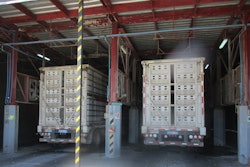Poultry industry professionals from around the country recently met in Nashville, Tennessee, for USPOULTRY’s 2019 Poultry Processor Workshop. The importance of maximizing yield and creating effective, efficient plant management systems is always on the minds of those in the processing industry, and the prevalence of these concerns was evident in this year’s program topics. In their joint presentation on woody breast syndrome, Dr. Casey Owens-Hanning, professor at the University of Arkansas, and Dr. Brian Bowker, research food technologist for USDA-ARS, addressed some of these concerns. Dr. Owens-Hanning’s discussion focused on the creation of efficient scoring systems to avoid affected meat going to market in a form undesirable to consumers. In his presentation, Dr. Bowker offered various processing solutions to avoid economic loss, suggesting that the textural evidence of woody breast syndrome may not be as noticeable if portioned and processed differently.
“It has been established that as an intact breast fillet product, woody breast has some problems texturally and visibly,” remarked Bowker. “The key takeaway here is that if you are taking a step to break down that muscle tissue – whether it’s grinding, chopping, flaking, anything like that – the texture attributes are going to be minimized.”
In her presentation on USPOULTRY-funded research involving peracetic acid exposure in poultry plants and potential control strategies, Jenny Houlroyd, senior research scientist at the Georgia Tech Enterprise Innovation Institute, discussed the considerable variation and lack of precision between tested methods related to exposure of peracetic acid. Houlroyd stressed the importance of continuing research in this area, stating, “We are in a quandary when it comes to really understanding what exposure is considered acceptable when it comes to peracetic acid, as there is not currently a regulatory standard for this chemical.”
Paul Bredwell, vice president of environmental programs for USPOULTRY, addressed topics that are prompted by the use of peracetic acid as an antimicrobial intervention in poultry harvest facilities. His presentation addressed the chemical properties of peracetic acid, proper handling and storage protocols to enhance worker safety in the work environment, current worker exposure standards and potential environmental compliance concerns that could result from insufficient control.
Dr. Barbara Masters, vice president of regulatory policy, food and agriculture for Tyson Foods, addressed best practices regarding food safety assessments. In addition to explaining the social and industrial factors that often trigger an increase in food safety assessments, she stressed the inevitability of inspections. Masters encouraged the creation of detailed food safety systems before assessment even takes place, maximizing the efficiency of any necessary corrective action.
















